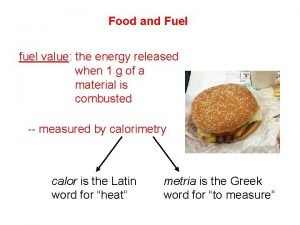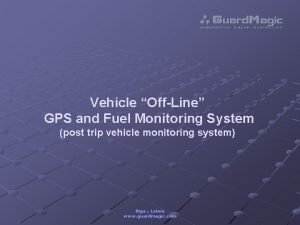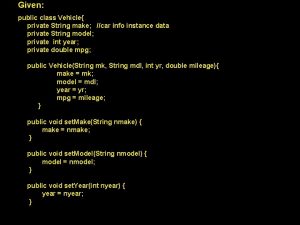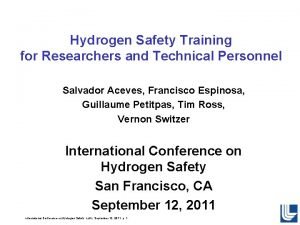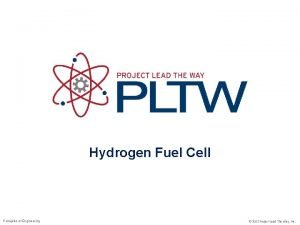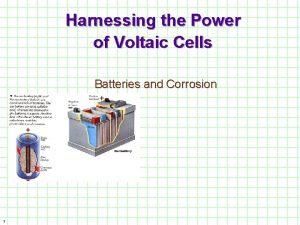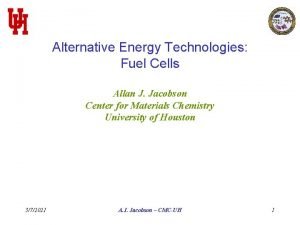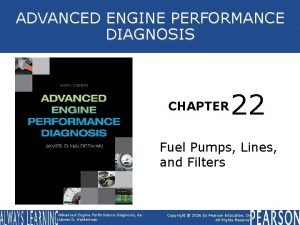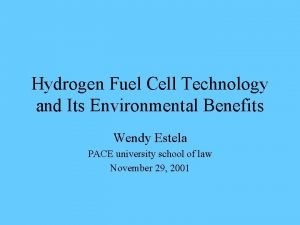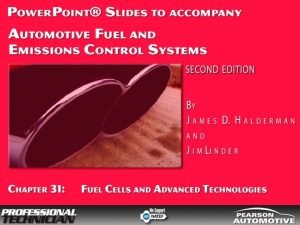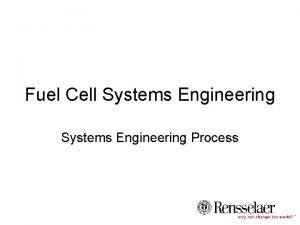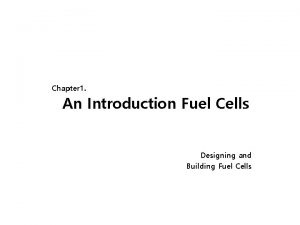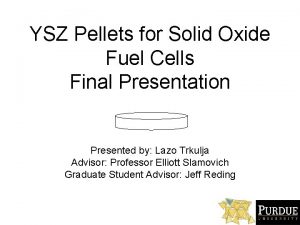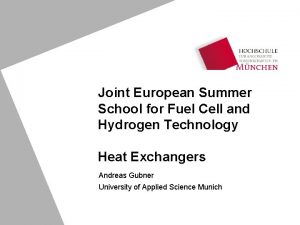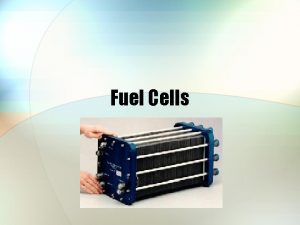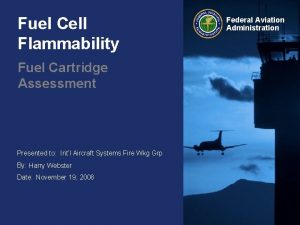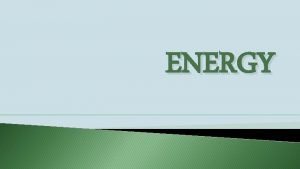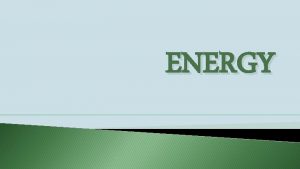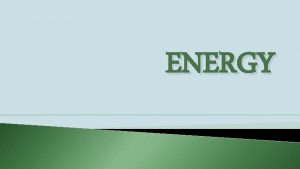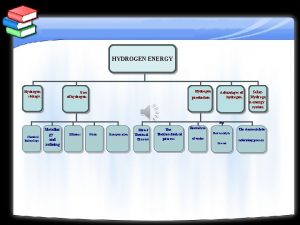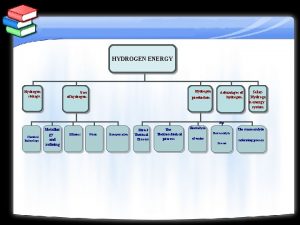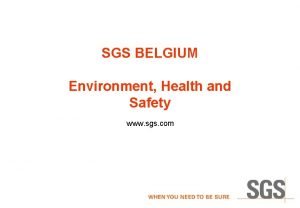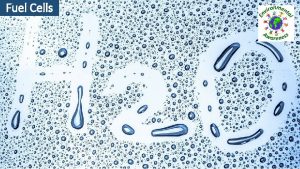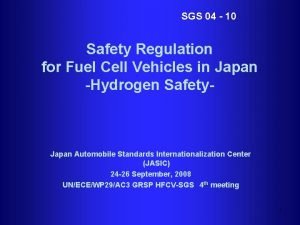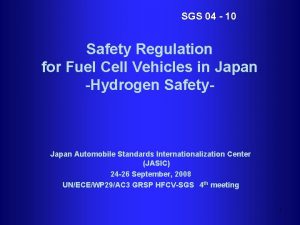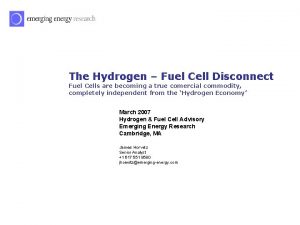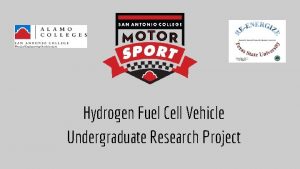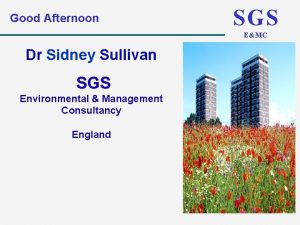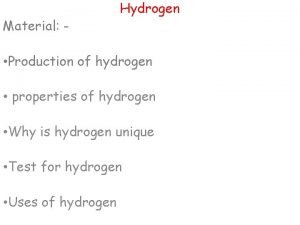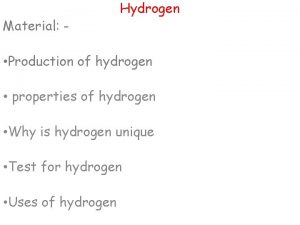SGS 04 07 Hydrogen Fuel Cell Vehicle Safety















- Slides: 15

SGS 04 - 07 Hydrogen Fuel Cell Vehicle Safety Research to Support Rulemaking/GTR Objectives September 2008 Draft Deliberative Document 1 of 15

Overview n n n GTR Action Plan Safety Issues Alternative Approaches Research/Rulemaking Goals Research Tasks Schedule Draft Deliberative Document 2

GTR Action Plan ECE/TRANS/WP. 29/2007/41 (April 2007) n Objective n n Attain equivalent levels of safety to conventional gasoline vehicles Develop a global technical regulation concerning hydrogen/fuel cells Performance based and does not restrict future technologies Content: n n n Performance requirements for fuel containers Electrical isolation Maximum allowable hydrogen leakage Draft Deliberative Document 3

Safety issues to be addressed Fuel system crashworthiness n n Hydrogen leakage limits Electrical integrity of high voltage fuel cell propulsion system High pressure container safety Safety level consistent with gasoline, CNG, conventional electric hybrids n n FMVSS Nos. 301, 303, 304, and 305 Draft Deliberative Document 4

Approaches to address fuel system crashworthiness n Hydrogen leakage limits n n n Electrical integrity of high voltage fuel cell propulsion system n n n Hydrogen (SAE) vs. helium surrogate (SAE, Japan, OICA, FMVSS) High pressure vs. low pressure and scaling up (SAE) Active fuel cell with hydrogen onboard vs. Inactive fuel cell, system “off” (SAE, AIAM, Japan) High pressure container safety n n n Cumulative life cycle and extreme use durability (SAE) vs. discrete testing (i. e. , FMVSS, CSA/NGV 2, HGV 2, ISO, EIHP, etc. ) Localized flame impingement (SAE) vs. bonfire (FMVSS, etc. ) High pressure (FMVSS No. 303) and/or low pressure (SAE, GM) – vulnerability to impact is greater at low pressure Draft Deliberative Document 5

Issues Associated with Each Fueling Approach for Crash Testing n High pressure hydrogen n n High pressure helium n n n + Electrical system is operational + Worse case for leak rate - Poses additional fire hazard + Consistent with FMVSS Nos. 301, 303 + Non-flammable - Surrogate leak rate is slightly different - Electrical system is not operational Low pressure hydrogen option n + Electrical System operational - Must scale up leak rate to represent worse case at high pressure +/- Cylinders more vulnerable to impact at low pressure Draft Deliberative Document 6

Research/Rulemaking goals n Conduct research to assess all proposed alternatives n n Prescribe additional requirements if results indicate safety need, e. g. : n n n Confirm that selected alternative detects potential failure Localized flame impingement test replaces bonfire test for hydrogen containers Extend post-crash leakage measurement beyond 60 minutes to adjust for reduced flow rate of helium through same sized orifice Prefer selecting option that is analogous to and consistent with existing requirements n n High pressure helium Single crash test for both electrical isolation and fuel leakage Draft Deliberative Document 7

Research Tasks to Support Rulemaking/GTR Objectives n n n Localized flame impingement on hydrogen storage cylinders Cumulative cylinder life cycle testing Comparative assessment of fueling options for crash testing Fire safety of proposed leakage limits Electrical isolation testing in the absence of hydrogen Draft Deliberative Document 8

Localized flame impingement on hydrogen storage cylinders n FMVSS No. 304 n n n Localized flame impingement (SAE) n n Real world data indicates Type IV composite cylinders do not vent in localized fire Lack of heat transfer to PRD Composite loses structural integrity, resulting in catastrophic rupture Research Task: n n n Requires bonfire test Cylinder must survive engulfing fire for 20 minutes or vent contents Localized fire test procedure – Developed by Powertech under contract to Transport Canada. Verification testing – Conducted under contract to NHTSA. Cylinders which have failed in real world fires will be tested and mitigating technologies will be assessed (heat transfer, sensing, shielding) Possible Outcome: n Requirement for localized flame test Draft Deliberative Document 9

Cumulative cylinder life cycle testing n Generate simulated real-world life cycle data n n Research Task: n n n SAE TIR 2579 expected service and durability testing. (pneumatic gas cycling, parking, extreme temperature, flaw, chemical tolerance, burst) Test procedures developed under contract to DOE/NREL Japan considering similar requirements in new standard, JARI 001 upgrade. Initial results indicate that altering test protocol effects results Conduct life cycle testing on representative hydrogen storage systems, vary test conditions to represent different service conditions Possible Outcome: n n Requirement for pneumatic rather than hydraulic pressure cycling test (FMVSS No. 304) Requirement for post pressure-cycle burst strength Draft Deliberative Document 10

Comparative assessment of fueling options for crash testing n Fueling options advocated by industry n n Research task: n n n High pressure hydrogen (SAE) High pressure helium (SAE, Japan) Low pressure hydrogen (SAE, GM) Conduct testing to compare container vulnerability to impact at high and low pressure fill Conduct leakage tests of hydrogen and helium at high and low pressure fill for a range of cylinder sizes Possible Outcome: n Selection of most appropriate fill option for assessing pass/fail leakage and fuel system vulnerability per FMVSS crash conditions Draft Deliberative Document 11

Fire safety of proposed leakage limits n n Hydrogen concentrations exceed lower flammability limit in vehicle compartments Research Task: n n Conduct hydrogen ignition tests in the trunk, engine and occupant compartments of vehicles and crash tested ICE vehicles Outcome: n Confirmation of the fire safety of proposed leakage limits, which are currently based on thermal energy equivalent to gasoline Draft Deliberative Document 12

Electrical isolation testing in the absence of hydrogen n Fuel cell produces no voltage when crash test is conducted using helium surrogate n n Research Task: n n Measure isolation by applying test voltage from an external source (megohmmeter) Conduct isolation testing with no hydrogen present, using megohmmeter Possible Outcome: n Confirm that testing can be conducted with the megohmmeter, without inducing damage to the vehicle propulsion circuit Draft Deliberative Document 13

R&D Timeline to Support Rulemaking Objectives Draft Deliberative Document 14

Schedule n n n Localized flame impingement on hydrogen storage cylinder: 6 months Cumulative cylinder life cycle testing: 15 months Comparative assessment of fueling options for crash testing: 15 months Fire safety of proposed leakage limits: 12 months Electrical isolation testing in the absence of hydrogen: 12 months Draft Deliberative Document 15
 Valuetheenergy.com
Valuetheenergy.com Fuel monitoring system for vehicles
Fuel monitoring system for vehicles Public class car
Public class car Hydrogen safety training
Hydrogen safety training What is fuel cell in chemistry
What is fuel cell in chemistry Fuel cell apollo
Fuel cell apollo Fuel cell apollo
Fuel cell apollo Roller cell fuel pump
Roller cell fuel pump Fuel cell forklift
Fuel cell forklift Fuel cell uses
Fuel cell uses Fuel cell system
Fuel cell system Molten carbonate fuel cell
Molten carbonate fuel cell Solid oxide fuel cell
Solid oxide fuel cell Fuel cell heat exchanger
Fuel cell heat exchanger Hydrogen energy advantages and disadvantages
Hydrogen energy advantages and disadvantages Fuel cell cartridge
Fuel cell cartridge
